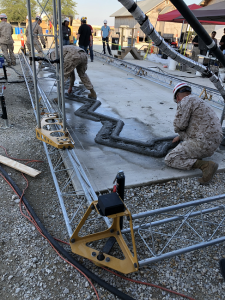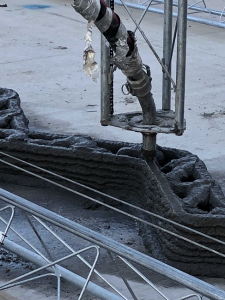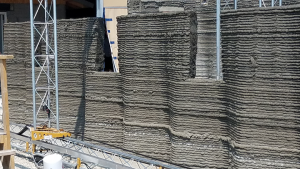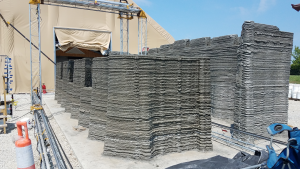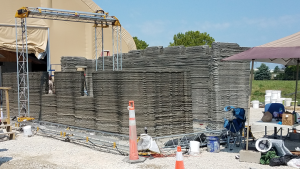Contour Crafting Will Develop Concrete 3D Printer for Disaster Relief, Thanks to DoD Contract
One of the very first methods of large-scale 3D printing that the world witnessed was the technology of Contour Crafting Corporation, which uses large but lightweight robotic 3D printers to quickly put down layers of building material in order to rapidly create entire buildings onsite in just days.
Last week, we learned that the US Department of Defense (DoD) had recently awarded California-based Contour Crafting a $3 million research and development contract, effective July 25th, 2018, in the large-scale, construction 3D printing domain. Contour Crafting will use this Rapid Innovation Fund (RIF) to build a concrete 3D printer for the purposes of Rapid Response Construction – quickly constructing buildings for disaster relief, an application that often makes use of 3D printing.
According to the company’s website, “The outcome of this funded R&D program is expected to be a technology which, among other applications, will effectively respond to disaster relief situations with expedient, safe and sustainable structures and buildings.”
The RIF was awarded to Contour Crafting based on its proposal, titled “Autonomous Construction Equipment and Sensing (ACES).” I assume this ACES is not to be mistaken for the US Army’s other ACES program, but as the location on the Federal Business Opportunities page is listed as CERL in Champaign, Illinois, one can’t be too sure.
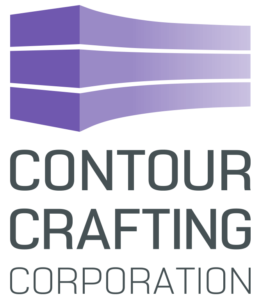 Regardless, this contract award to Contour Crafting confirms that the DoD is interested in seeking outside help for its construction 3D printing goals, as opposed to just keeping things in-house…never a bad idea.
Regardless, this contract award to Contour Crafting confirms that the DoD is interested in seeking outside help for its construction 3D printing goals, as opposed to just keeping things in-house…never a bad idea.
Speaking of construction 3D printing goals, Contour Crafting is on a mission to commercialize disruptive construction technologies, and this funding award from the DoD should definitely help the company on its way to achieving it.
In 2015, Dr. Behrokh Khoshnevis, who developed the company’s Contour Crafting technology at the University of Southern California and is its CEO and founder, predicted during an interview with 3DPrint.com that 3D printed homes would be widespread within five years. While the 3D printed housing sector is certainly hard at work, we are definitely not there yet. However, 3D printed construction technology does seem to be the perfect answer for smaller structures, like an army barracks and emergency housing, so it’s smart to focus on these while continuing to build up the technology until it’s ready.
While I did not learn too much more about the company’s newly awarded DoD contract, perhaps due to a non-disclosure agreement or something similar, Dr. Khoshnevis was kind enough to answer some questions for me in regards to Contour Crafting’s construction 3D printing technology, as well as the company’s plans for the future.
How does Contour Crafting’s technology compare to other construction 3D printing?
“CC Corp is currently pursuing both construction and non-construction application domains. The latter has the main advantage of not being subject to regulatory restrictions and the complex and potentially costly process of obtaining approval of regulatory authorities for conformance to building codes, which incidentally is different for different localities because of varying factors such as extent of seismic activities and climatic conditions.
“In the field of construction we are advancing more cautiously as we are exploring potential implementation problems and solutions. We are doing many experimentations in-house and are preparing for some field tests as well.
“We have maintained our interest in the field of planetary construction as our prior accomplishments in the field, which include two NASA international competition Grand Prizes, have been noteworthy. We are developing new technologies for in-situ material usage for construction of a variety of useful infrastructure elements such as landing pads, blast protection walls, shade walls, radiation shielding walls, hangars, and roads.”
Discuss this story and other 3D printing topics at 3DPrintBoard.com or share your thoughts in the Facebook comments below.
Live Demonstration of ACES Concrete 3D Printing Technology at CERL to 3D Print Barracks: Part 3
As part of a three-year program called Automated Construction of Expeditionary Structures (ACES), last year the US Army 3D printed a complete barracks, also known as a B-Hut, out of a patented concrete mixture. The program is researching 3D printing as a way to build semi-permanent structures out of concrete, made from locally available materials – the goal is to reduce the amount of building materials that need to be shipped out by half, and decrease construction manpower requirements by 62%, when compared to expedient plywood construction.
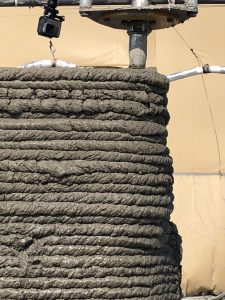 Last week I was invited out to the Engineer Research and Development Center’s Construction Engineering Research Laboratory (CERL) in Champaign, Illinois for a live demonstration of the ACES technology…an invitation I was happy to accept. Last year’s B-hut took 21.5 hours to print, but that’s the total number of print hours, and wasn’t continuous. This time, the ACES team, with assistance from its project partner – Chicago-based architectural and engineering firm Skidmore, Owings, and Merrill (SOM) – and Marines from the 1st Marine Expeditionary Force, was going to attempt something new.
Last week I was invited out to the Engineer Research and Development Center’s Construction Engineering Research Laboratory (CERL) in Champaign, Illinois for a live demonstration of the ACES technology…an invitation I was happy to accept. Last year’s B-hut took 21.5 hours to print, but that’s the total number of print hours, and wasn’t continuous. This time, the ACES team, with assistance from its project partner – Chicago-based architectural and engineering firm Skidmore, Owings, and Merrill (SOM) – and Marines from the 1st Marine Expeditionary Force, was going to attempt something new.
The ambitious plan was to complete the two halves of another barracks structure, completely out in the open and not covered by a tent, in 24 hours of continuous 3D printing. What moves the demonstration from ambitious to brave was the team’s decision to invite journalists to see the live print, and I’m not just talking about myself – I saw cameramen and reporters onsite from at least two different local TV stations.
The Marines were briefed on the specifics of the technology ahead of time, and ran the equipment themselves this week, as they will be the ones actually 3D printing the structures in the future if the program is successful. However, the ACES team and SOM were onsite in case they needed to offer any assistance, and that assistance was needed a time or two during the live demonstration.
Program manager Michael Case, PhD, told me that an issue with concrete is evaporation drying, so when the forecast showed rain, the start time was moved up a few hours, only to halt again pretty quickly once the team realized that they needed a new pump – the interior of the original one had been torn up by the sharper materials used during a live demonstration at Fort Leonard Wood a few months ago. Then the kinks needed to be worked out of the hose, and when the material didn’t extrude properly after the print began, the team removed the nozzle and discovered that a rock was inside messing up the flow.
The material mixture had to be adjusted after the first layer because it was too sloppy, at one point the nozzle was accidentally sent over to the side that wasn’t being worked on yet, and when steel dowels were added for initial reinforcement to the first several layers of 3D printed concrete, work began on the wrong side. But in spite of these minor setbacks, work continued through the night and Public Affairs Specialist Mike Jazdyk told me that there were very few clogs.
On the morning of the second day of printing, Jazdyk told me that the ACES team would not make its original goal of a continuous, 24 hour 3D printed concrete barracks. A lot of this was due to concrete curing inside of the pump, which caused the equipment to shut down and cause some overnight delays. By the time I had to head for home, the team had nearly completed the first half of the structure and was planning to take several hours of much-needed rest before starting in on the second half. Jazdyk informed me that work would begin again around midnight.
I received a call from Jazdyk on Friday afternoon, and he told me that the ACES team had to stop the print due to equipment failure, but that they had managed to complete roughly 80% of the structure before this happened – this is easy to see in the image below.
“What you see is 40 hours of printing,” Jazdyk told me about these four photos he sent, noting that this number does not denote a continuous job, but rather is the total number of print hours.
Jazdyk explained that had the equipment not failed, the ACES team at CERL would have finished the structure in less than 48 hours, which is still an extremely impressive feat. As previously mentioned, the fact that the team was willing to have the press onsite for the live demonstration, without knowing for certain if they would make their goal, was valiant.
 So often with 3D printed construction projects, we are assaulted with people and companies saying, “Look, I’m the first!” or “I did it the fastest!” or “I built the biggest thing in the world!” At CERL this week, everyone I spoke to was very candid with the issues the project was running into, and no one tried to pull the wool over my eyes or move me away if something went awry. People answered every question I asked openly and honestly, even if it was a question relating to something that was currently going wrong – this is admirable.
So often with 3D printed construction projects, we are assaulted with people and companies saying, “Look, I’m the first!” or “I did it the fastest!” or “I built the biggest thing in the world!” At CERL this week, everyone I spoke to was very candid with the issues the project was running into, and no one tried to pull the wool over my eyes or move me away if something went awry. People answered every question I asked openly and honestly, even if it was a question relating to something that was currently going wrong – this is admirable.
“No one shows you under the skirts of large-scale concrete 3D printing – all you see are the videos that are posted online of just what people want you to see, and nothing else,” project manager Megan Kreiger told me. “You don’t see all the problems that you have to overcome. They make it look like they’re doing it super fast, super easy, and that they’re doing it under 24 hours, but none of it’s true.”
Team members also shared their hopes for the program with me, like ultimately lowering the cost of materials and the amount of manpower needed, and the potential applications the ACES technology could eventually be used for other than 3D printing buildings, such as culverts, barriers, and bridges, and more humanitarian efforts, like schools.
“There’s a tremendous number of uses,” Dr. Case told me.
Jazdyk told me today that they will attempt to complete the 3D printed concrete structure next week at CERL. I am confident that they will succeed, but, knocking on wood and knowing that sometimes things just go wrong, I am also confident that should more problems arise, the ACES team will handle them with grace, learn from them, and keep on trucking.
Stay tuned to 3DPrint.com for more news about my recent visit to CERL, including plenty of information that I did not previously know about concrete and the importance of the shape of these 3D printed walls.
Discuss this story and other 3D printing topics at 3DPrintBoard.com or share your thoughts in the Facebook comments below.
[Images: Sarah Saunders for 3DPrint.com, unless otherwise noted]
Live Demonstration of ACES Concrete 3D Printing Technology at CERL to 3D Print Barracks: Part 2
I was recently invited to the US Army’s Engineer Research and Development Center’s (ERDC) Construction Engineering Research Laboratory (CERL) in Illinois to see a live demonstration of its Automated Construction of Expeditionary Structures (ACES) technology. Last year, the US Army used ACES to 3D print a complete barracks, or B-Hut, in 21.5 hours with the Army’s patented concrete mixture.
Having only seen still images and video of this unique technology, I knew I couldn’t pass up the opportunity to see a 512 square foot barracks 3D printed live in front of my very eyes within 24 hours. So yesterday afternoon, I hopped in my car for the roughly four-hour drive out west to Champaign.

A closer look at a completed section.
The goal for this ACES demonstration is to successfully 3D print the exterior concrete walls of a 8 foot building in 24 hours. While the ACES team and its project partner, Chicago-based architectural and engineering firm Skidmore, Owings, and Merrill (SOM), are both onsite, Marines from the 1st Marine Expeditionary Force are running the equipment; obviously, if the project is successful and this technology is able to be deployed overseas to our troops in the future, they will be the ones actually 3D printing the structures.
Benton Johnson, PE, SE, the Associate Director at SOM, told me yesterday that the Marines were briefed on the ACES technology and equipment via conference call and email. From the looks of things, they seemed to have gotten the hang of everything – preparing and mixing the materials, running the computer, cleaning up the printed layers by hand and clearing away material from the bolts, etc. Johnson pointed out that the main coder of the project was onsite, but only to offer assistance if needed.
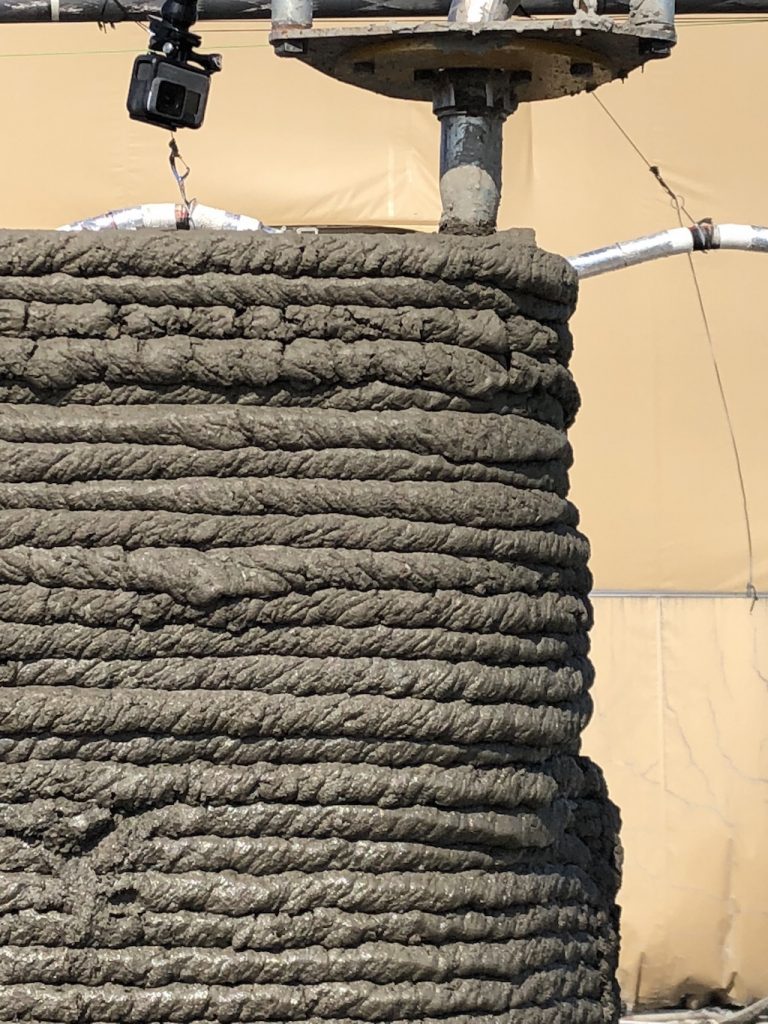
A close up of the nozzle 3D printing the barracks. Image Sarah Saunders.
“I think part of this is a learning curve, because all the Marines that were out there operating the machinery had never seen this or touched it before,” Captain Matt Friedell told me.
“But they took to it, and once they learned it, they started to get in their groove and really pick up the pace. And we knew when we were going to attempt this that it was going to be a challenge.”
Obviously, there were a few glitches, as people rarely get the hang of new technology perfectly the first time out. The barracks is being 3D printed in two halves, and at one point the Marine running the computer accidentally sent the nozzle over to the side that wasn’t being worked on yet; later, when steel dowels were being added for initial reinforcement to the first 18″ or so of 3D printed concrete, work began on the wrong side. But none of this seemed to slow the process down.
However, as I mentioned yesterday, things did not start off swimmingly. Program manager Michael Case, PhD, told me that one of the issues with concrete is evaporation drying. So when the forecast showed rain today, the start time of the demonstration was moved up a few hours, only to halt again pretty quickly. Dr. Case explained that the material used at the Fort Leonard Wood demonstration a few months ago was sharper and more angular than it is here at CERL, and tore up the inside of the pump.
By the time the team finished replacing the pump and working the kinks out of the hose, it was almost the original start time of 5 pm. it looked like things were going to start moving, until the material didn’t extrude properly and some team members removed the nozzle to find that a rock inside was jamming things up. When the concrete finally started to print, the material mixture had to be adjusted after the first layer because it was too sloppy. But once this was fixed, things really took off, and work continued through the night, with very few clogs.
Spoiler alert: when I arrived back at CERL this morning, I learned that the team would not be able to make its original deadline of 24 hours. Dr. Case explained that “a big part of this is to figure out how long you can continuously use the equipment.”
“So we learned a lot about things…If you operate this type of concrete printing equipment long enough, you have to stop and service some of the equipment.”
Dr. Case said that if you don’t clean out the equipment, you can get concrete curing inside of the pump, and that it will eventually shut down, which caused some delays overnight. So by about 9 am this morning, the team had nearly completed the first half of the structure, and was planning on taking a few hours of much-needed rest before starting in on the second half.
While the ACES team won’t make the original goal of a continuous 24 hour print, the work they’ve completed and will continue throughout the rest of the day, is extremely impressive. Capt. Friedell told me as I was leaving CERL that he was certain this project is the tallest continuous 3D print in the US.
Stay tuned to 3DPrint.com for a more in-depth look at my visit to CERL this week! So far it has been very exciting to be able to have unfettered access to the site and to have been given access to all of the people involved. Issues with extrusion, rain and the weather that this team had actually made me question more the validity of some “3D printing a house in a day” claims. What this team ancountered were real-life challenges brought on by equipment and the weather that slowed them down. I think that CERL’s effort, undertaken with a journalist present, was much more transparent, open and honest than the commercial house printing initiatives who somehow always tell us after the fact the great feats that they’ve accomplished. I can now really see the value that house 3D printing could have for the Marine Corps, Army and for civilian use. Most of all I’m grateful that I got an up close and personal look at what it actually takes to 3D print a structure.
Discuss this story and other 3D printing topics at 3DPrintBoard.com or share your thoughts below.
[Images: Sarah Saunders for 3DPrint.com]






